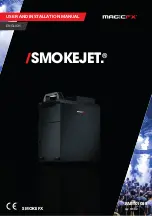
29
Español
CAPÍTULO 8
INTRODUCCIÓN DE PRENSATELAS OPCIONAL
6. Baje la palanca del prensatelas y ajuste la guía
del tejido hacia el borde doblado.
7. Ajuste la posición de la guía del prensatelas
con el tornillo de ajuste de modo que la
máquina toque ligeramente el pliegue en la
tela. En este caso, el criterio es el grosor de la
tela.
Al girar el tornillo hacia delante (hacia usted),
la guía del tejido irá a la derecha. Al girar el
tornillo hacia atrás (opuesto a usted), la guía
del tejido irá a la izquierda.
!
"
3
Tornillo de ajuste
4
Guía del tejido
Para ajustar la posición de la guía del tejido,
se debe utilizar un pedazo del mismo tejido
para hacer una prueba de costura.
8. Si el tejido se dobla con la mano, cosa de
modo que la aguja sólo alcance el borde del
pliegue.
9. Abra el tejido como se muestra en la
ilustración.
Para obtener mejores resultados, utilice un hilo
fino en un color que coordine con el tejido.
Si se hace correctamente, esta puntada
apenas se verá en el derecho del tejido.
Puntadas overlock planas
Las puntadas overlock planas se usan
principalmente para lograr un acabado decorativo
en un trabajo. Una vez terminadas, las puntadas
pueden parecerse a una escalera o a pequeñas
líneas paralelas cuando se estira el tejido plano.
Ajustes recomendados
- Ancho de las puntadas: 5 mm
- Largo de las puntadas: 2 - 4 mm
- Tensión del hilo de la aguja: 0-3
- Tensión del hilo del áncora superior: 2-5
- Tensión del hilo del áncora inferior: 6-9
PRECAUCIÓN
Apague la máquina al sustituir el prensatelas.
Prensatelas para puntadas invisibles
Características
Al utilizar el prensatelas para puntadas invisibles
(prensatelas multipropósito), puede coser
puntadas invisibles y overlock al mismo tiempo.
Es ideal para coser puños, bajos de pantalones,
bolsillos, dobladillos de faldas, etc.
La guía de puntadas de este prensatelas también
es útil para coser puntadas overlock planas,
pliegues y otras puntadas decorativas.
Puntadas invisibles
La puntada de dobladillo invisible se utiliza para
realizar un dobladillo casi invisible en prendas o
en trabajos para decoración de hogar. Utilícela en
dobladillos de pantalones, faldas o cortinas.
Ajustes recomendados
- Ancho de las puntadas: 5 mm
- Largo de las puntadas: 3 - 4 mm
- Tensión del hilo de la aguja: un poco flojo (0-2)
- Tensión del hilo del áncora superior:
un poco apretado (5-7)
- Tensión del hilo del áncora inferior:
un poco flojo (2-4)
Procedimiento
1. Conecte el prensatelas para puntadas
invisibles (véase el CAPÍTULO 1 “Instalación/
desmontaje del prensatelas”).
2. Ajuste la máquina para puntada overlock de 3
hilos con una aguja en la posición izquierda.
La aguja de la derecha se debe quitar.
3. Gire el revés de la tela hacia fuera, doble la
tela una vez y de nuevo hacia atrás el ancho
necesario, como se ilustra a continuación.
1
2
1
Revés
2
Paso de la aguja
La costura será más sencilla si se plancha un
pliegue en la tela doblada antes de coser.
4. Gire la ruedecilla hasta que la línea de la
misma quede alineada con la línea de la
máquina (véase el CAPÍTULO 1 “Cambio de
la dirección de la ruedecilla”).
5. Levante la palanca del prensatelas e inserte el
tejido con el borde doblado a la izquierda para
que la aguja perfore justo el borde doblado al
coser.
Summary of Contents for 884-B01
Page 78: ...36 ...










































